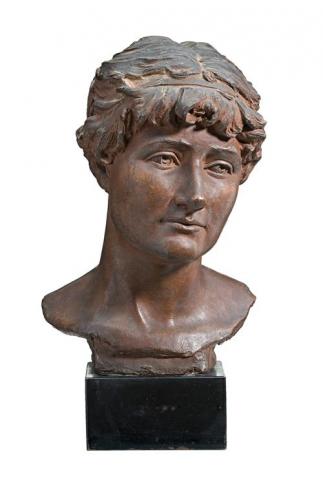HEAD OF A WOMAN (MARY ANDERSON), 1888
Bertram Mackennal
terracotta
35.0 cm height
inscribed lower left: E. B. MACKENNAL / LONDON 1888
Len Annois, Melbourne
Thence by descent, Mr Richard Annois, Geelong
Bertram Mackennal: The Fifth Balnaves Sculpture Project, Art Gallery of New South Wales, Sydney, 17 August – 4 November 2007; National Gallery of Victoria, Melbourne, 30 November 2007 – 24 February 2008
Edwards, Deborah, et al., Bertram Mackennal, Art Gallery of New South Wales, Sydney, 2007, pp. 24, 143, 146–7 (illus.), 151, and catalogued in accompanying CD–ROM
Portrait Head, 1888, terracotta, 32.0 x 21.0 x 24.5 cm, National Gallery of Australia, Canberra
The story of Pygmalion from classical legend has had a special appeal for sculptors as the tale of a statue so beautiful that it came to life through Aphrodite's response to the entreaties of its creator. Its appeal throughout the centuries has inspired poets, painters, playwrights, sculptors and musicians as diverse as Ovid, Dryden, Goya, Rodin, Donizetti and Shaw, its most recent incarnation as My Fair Lady. With the 1883 revival at London's Lyceum Theatre of Pygmalion and Galatea by W. S. Gilbert, of operetta fame, the highly talented American actress Mary Anderson (1859-1940) thrilled her London audiences with one of her finest performances, and Head of a Woman has long been considered a remarkable likeness of her.
From the late 1880s, leading theatrical figures were Mackennal's richest source of commissions. They included several of the great Sarah Bernhardt and, like his compatriot Rupert Bunny, Nellie Melba at the height of her fame. The first of such portrait busts was Mary Anderson, another version of which is in the collection of the National Gallery of Australia, Canberra.1 On her London debut, she was praised for her 'natural gifts of rare excellence'.2 Within a few months she was 'the rage' of London, while her appearance in Pygmalion was applauded for 'the statuesque beauty of her appearance and the classic grace of all her movements.'3
Mackennal would have been aware of this singular beauty, yet it was probably her 1887 star performance in the dual roles of Hermoine and Perdita in Shakespeare's The Winter's Tale that inclined him to translate her back into stone, or in this case, terracotta. He was very active in theatrical circles and would have seen Anderson in performance, as well as socially. Previously a reviewer for the London Morning Post had written:
Miss Anderson's beauty is of a Grecian type, with a head of classic contour, finely chiselled features, and a tall statuesque figure, whose Hellenic expression a graceful costume of antique design sets off to best advantage.'4
This is echoed in Mackennal's portrait, modelled in London before he returned to Australia to take up his first major commission, the allegorical reliefs for the exterior of Parliament House, Melbourne. Anderson, who retired from the stage in 1889, was also a devotee of Shakespeare, having performed in roles as diverse as Juliet and Lady Macbeth, and to acclaim as Rosalind for the opening of the Shakespeare Memorial Theatre at Strafford upon - Avon. Her many admirers included the Prince and Princess of Wales, Tennyson, and numerous artists and photographers, and there are many images of her in the National Portrait Gallery, London.
1. Edwards, op. cit, p. 143
2. The Times, London, 3 September 1883, this and the following two are quoted in Farrar, J. M., Mary Anderson, online book, Project Gutenberg, 22 January 2005, www.gutenberg.org
3. The Graphic, London, 14 December 1883
4. Morning Post, London, 3 September 1883, also quoted in Edwards, op. cit, p. 143
DAVID THOMAS
